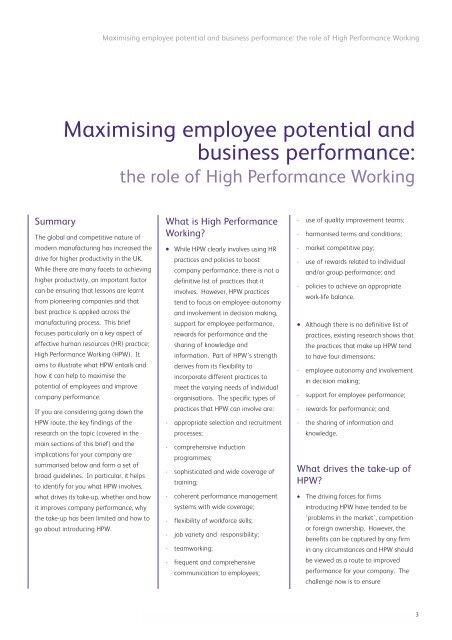About EEF - CIPD
About EEF - CIPD
About EEF - CIPD
You also want an ePaper? Increase the reach of your titles
YUMPU automatically turns print PDFs into web optimized ePapers that Google loves.
Maximising employee potential and business performance: the role of High Performance WorkingMaximising employee potential andbusiness performance:the role of High Performance WorkingSummaryThe global and competitive nature ofmodern manufacturing has increased thedrive for higher productivity in the UK.While there are many facets to achievinghigher productivity, an important factorcan be ensuring that lessons are learntfrom pioneering companies and thatbest practice is applied across themanufacturing process. This brieffocuses particularly on a key aspect ofeffective human resources (HR) practice;High Performance Working (HPW). Itaims to illustrate what HPW entails andhow it can help to maximise thepotential of employees and improvecompany performance.If you are considering going down theHPW route, the key findings of theresearch on the topic (covered in themain sections of this brief) and theimplications for your company aresummarised below and form a set ofbroad guidelines. In particular, it helpsto identify for you what HPW involves,what drives its take-up, whether and howit improves company performance, whythe take-up has been limited and how togo about introducing HPW.What is High PerformanceWorking?• While HPW clearly involves using HRpractices and policies to boostcompany performance, there is not adefinitive list of practices that itinvolves. However, HPW practicestend to focus on employee autonomyand involvement in decision making,support for employee performance,rewards for performance and thesharing of knowledge andinformation. Part of HPW’s strengthderives from its flexibility toincorporate different practices tomeet the varying needs of individualorganisations. The specific types ofpractices that HPW can involve are:- appropriate selection and recruitmentprocesses;- comprehensive inductionprogrammes;- sophisticated and wide coverage oftraining;- coherent performance managementsystems with wide coverage;- flexibility of workforce skills;- job variety and responsibility;- teamworking;- frequent and comprehensivecommunication to employees;- use of quality improvement teams;- harmonised terms and conditions;- market competitive pay;- use of rewards related to individualand/or group performance; and- policies to achieve an appropriatework-life balance.• Although there is no definitive list ofpractices, existing research shows thatthe practices that make up HPW tendto have four dimensions:- employee autonomy and involvementin decision making;- support for employee performance;- rewards for performance; and- the sharing of information andknowledge.What drives the take-up ofHPW?• The driving forces for firmsintroducing HPW have tended to be‘problems in the market’, competitionor foreign ownership. However, thebenefits can be captured by any firmin any circumstances and HPW shouldbe viewed as a route to improvedperformance for your company. Thechallenge now is to ensure3
















